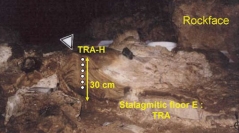

 Comptes Rendus Palevol
10 (7) - Pages 577-587
Comptes Rendus Palevol
10 (7) - Pages 577-587This article presents the dating results recently obtained on three archaeological sites in Europe. At Orgnac 3 (Ardèche, France) from where the last Homo heidelbergensis fossils are associated with the first evidence of levallois technique, two speleothem formations from the 5b–6–7 th layers were U-Th dated with MC-ICPMS, giving an age range of 319–255 ka (2σ) (MIS 8–9), while the volcanic ash-bearing second layer was dated by 40Ar/39Ar, obtaining a preliminary date of 308.2 ± 6.8 ka (2σ). The combined ESR/U-Th dating of red deer enamel teeth from Lazaret cave (Alpes-Maritimes, France) attributed ages of 120–190 ka to the Acheulean and pre-Mousterian layers (MIS 6), which is in agreement with previous TIMS U-Th dates between 108 and 44 ka on calcite samples from the overlying TRA trench (MIS 5, 4, 3). At Zafarraya (Andalousie, Espagne), a number of 14C measurements on charcoal samples as well as combined ESR/U-Th dates on Capra and Equus dental enamels assigned the Mousterian artefacts and neandertalian fossils-bearing deposits an age interval between 42 and 34 ka (MIS 3).
Radiometric dating, Homo heidelbergensis, Neandertal, Acheulian, Mousterian